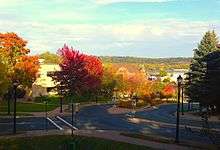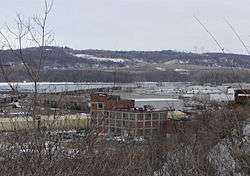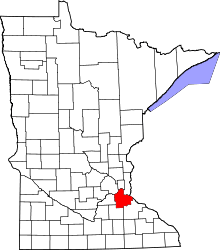South St. Paul, Minnesota
| South St. Paul, Minnesota | |
|---|---|
| City | |
| City of South St. Paul | |
|
View across the industrial neighborhood by the Mississippi River | |
| Nickname(s): S.S.P. | |
|
Motto:  Looking down Grand Avenue in South St. Paul towards the Mississippi River. | |
 Location of the city of South St. Paul within Dakota County, Minnesota | |
| Coordinates: 44°53′17″N 93°2′44″W / 44.88806°N 93.04556°W | |
| Country | United States |
| State | Minnesota |
| County | Dakota |
| South St. Paul | January 1, 1887 |
| Government | |
| • Type | Mayor (Municipal) |
| • Mayor | Beth Baumann |
| Area[1] | |
| • Total | 6.14 sq mi (15.90 km2) |
| • Land | 5.65 sq mi (14.63 km2) |
| • Water | 0.49 sq mi (1.27 km2) |
| Elevation | 719 ft (219 m) |
| Population (2010)[2] | |
| • Total | 20,160 |
| • Estimate (2015)[3] | 20,405 |
| • Density | 3,568.1/sq mi (1,377.7/km2) |
| Time zone | Central (CST) (UTC-6) |
| • Summer (DST) | CDT (UTC-5) |
| ZIP codes | 55075, 55076 |
| Area code(s) | 651 |
| FIPS code | 27-61492 |
| GNIS feature ID | 0652339[4] |
| Website | City of South St. Paul |
South St. Paul is a city in Dakota County, Minnesota, immediately south and southeast of the city of Saint Paul, Minnesota. It is also southeast of West St. Paul, Minnesota. The population was 20,160 at the 2010 census.[5] It is notable as one of the historic major meat packing cities in the United States. Subsequently, many residents are descendants of immigrants from Southern Europe and Eastern Europe.
A post office called South St. Paul has been in operation since 1888.[6] The city was named from its location south of St. Paul.[7]
Geography
According to the United States Census Bureau, the city has a total area of 6.14 square miles (15.90 km2), of which 5.65 square miles (14.63 km2) is land and 0.49 square miles (1.27 km2) is water.[1]
Interstate Highway 494, U.S. Highway 52, and Minnesota Highway 156 are three of the main routes in South St. Paul.
South St. Paul is home to a small general aviation airport, Fleming Field.
The main industry for much of South St. Paul's history was the Saint Paul Union Stockyards. These remain active but much reduced in size, and much of the stockyards area is being redeveloped.
As of 04/11/2008, the stockyards are closed.[8]
Demographics
| Historical population | |||
|---|---|---|---|
| Census | Pop. | %± | |
| 1880 | 489 | — | |
| 1890 | 2,242 | 358.5% | |
| 1900 | 2,322 | 3.6% | |
| 1910 | 4,510 | 94.2% | |
| 1920 | 6,860 | 52.1% | |
| 1930 | 10,009 | 45.9% | |
| 1940 | 11,844 | 18.3% | |
| 1950 | 15,909 | 34.3% | |
| 1960 | 22,032 | 38.5% | |
| 1970 | 25,016 | 13.5% | |
| 1980 | 21,235 | −15.1% | |
| 1990 | 20,197 | −4.9% | |
| 2000 | 20,167 | −0.1% | |
| 2010 | 20,160 | 0.0% | |
| Est. 2015 | 20,405 | [9] | 1.2% |
| U.S. Decennial Census[10] 2015 Estimate[3] | |||
2010 census
As of the census[2] of 2010, there were 20,160 people, 8,186 households, and 5,065 families residing in the city. The population density was 3,568.1 inhabitants per square mile (1,377.7/km2). There were 8,666 housing units at an average density of 1,533.8 per square mile (592.2/km2). The racial makeup of the city was 85.3% White, 3.9% African American, 0.8% Native American, 1.2% Asian, 0.1% Pacific Islander, 5.4% from other races, and 3.4% from two or more races. Hispanic or Latino of any race were 12.2% of the population.
There were 8,186 households of which 31.4% had children under the age of 18 living with them, 42.2% were married couples living together, 14.2% had a female householder with no husband present, 5.4% had a male householder with no wife present, and 38.1% were non-families. 30.1% of all households were made up of individuals and 10.1% had someone living alone who was 65 years of age or older. The average household size was 2.44 and the average family size was 3.04.
The median age in the city was 36.9 years. 23.8% of residents were under the age of 18; 8.4% were between the ages of 18 and 24; 28.8% were from 25 to 44; 27% were from 45 to 64; and 12% were 65 years of age or older. The gender makeup of the city was 49.2% male and 50.8% female.
2000 census
As of the census of 2000, there were 20,167 people, 8,123 households, and 5,255 families residing in the city. The population density was 3,515.9 people per square mile (1,356.5/km²). There were 8,313 housing units at an average density of 1,449.3 per square mile (559.2/km²). The racial makeup of the city was 92.63% White, 1.28% African American, 0.57% Native American, 0.82% Asian, 0.01% Pacific Islander, 2.80% from other races, and 1.90% from two or more races. Hispanic or Latino of any race were 6.42% of the population.
There were 8,123 households out of which 32.5% had children under the age of 18 living with them, 47.0% were married couples living together, 13.1% had a female householder with no husband present, and 35.3% were non-families. 28.8% of all households were made up of individuals and 10.8% had someone living alone who was 65 years of age or older. The average household size was 2.47 and the average family size was 3.05.
In the city the population was spread out with 25.4% under the age of 18, 9.0% from 18 to 24, 32.7% from 25 to 44, 20.1% from 45 to 64, and 12.8% who were 65 years of age or older. The median age was 35 years. For every 100 females there were 95.3 males. For every 100 females age 18 and over, there were 93.1 males.
The median income for a household in the city was $45,216, and the median income for a family was $54,119. Males had a median income of $36,466 versus $28,415 for females. The per capita income for the city was $21,396. About 4.1% of families and 6.1% of the population were below the poverty line, including 6.8% of those under age 18 and 5.7% of those age 65 or over.
Education
South St. Paul's Public School System contains two Elementary Schools, One Secondary School (6-12), and a Community Learning Center.
South St. Paul schools were established in 1853. The schools operated under the name Kaposia School District, serving the sons and daughters of local residents, missionaries, and the Kaposia Village Native American chiefs. Initially under the jurisdiction of Dakota County, the district included sections of West St. Paul, Sunfish Lake and Inver Grove Heights. In 1887, the county turned over the administration of the schools to the newly incorporated cities and their councils. South Saint Paul Special School District #6 was officially designated a school district in 1890 when voters established an independent Board of Education. Rapid growth in the city and its schools continued in the 1950s and 1960s, culminating in the 1970s when more than 6,000 students attended six elementary schools, a high school, and a junior high school. However, in the 1980s, enrollments in the South St. Paul schools began to decline and the community was forced to make the difficult decision to consolidate school buildings. During the same period, technology advances required the school district to be networked to keep up with the next generation of learners. In 1999, the South St. Paul community passed a technology referendum to maintain the quality of education in South St. Paul schools. The South St. Paul School District currently serves approximately 3,500 students in two elementary schools, one secondary school (grades 7-12), and an alternative learning center.
South St. Paul is also home to two Private Schools, Holy Trinity Catholic School, & St. John Vianney Catholic School.
Holy Trinity Catholic School
Holy Trinity School opened on September 7, 1954 with an enrollment of 243 students. The building consisted of 8 classrooms and a cafeteria in the basement and offered grades Pre-K through 8. On September 7, 1954, the size of the student body expanded at a rapid rate. At the beginning of the 1963-64 school year, the enrollment exceeded 600 students. The drop in enrollment bottomed out at 80 plus students during the 1984-85 school year. This same year a half day kindergarten was added to the regular 1 through 8 grade program. The following year, an all-day everyday kindergarten was established. A preschool was added in 1988. It now has several more classrooms and athletic programs.
St. John Vianney Catholic School
In 1956, SJV school opened its doors with 109 students in grades one through four. By 1958, the school contained grades one through eight. In 1974, a preschool and kindergarten program were added to the school. The fall of 1992 saw the establishment of a full day kindergarten program as well as an extended day program. SJV offered academic programs for preschool, kindergarten and grades 1 through 6, as well as an extended day program. St. John Vianney Catholic School is now closed, and is renting out the space to a charter school.
Religion
South St. Paul is home to a wide range of faith communities.
Grace Lutheran Church
Grace Lutheran Church is a Christian church of the Wisconsin Evangelical Lutheran Synod (WELS) in South St. Paul.[11]
Clark Memorial United Church of Christ
Established on October 25, 1887, the founder of the church was Charles W. Clark. The church has gone through many different remodels and building changes throughout the years. The church has been struck by fire many times, but the faithful community of this parish always seem to gather together and rebuild or renew the church. The mission of the church supports local, state, national and global interest of the congregation. The church also supports the ministry of the United Church of Christ as programs and needs arise. The congregation is mindful of the needs of Northern Dakota County (especially South St. Paul), and is committed to raise money and provide leadership within the community. The church also participates in city-wide events such as Kaposia Days and On the Road Again Days.[12]
St. Stephens Romanian Orthodox Church
St. Stefan Romanian Orthodox Parish was founded in 1923 by a group of Romanian emigrants; the church construction was finished in 1924. On June 27, 1924, the Parish was incorporated as a religious, non-profit organization, by the City of South St. Paul, Dakota County. In 1935 the church is blessed by Policarp Morusca, the first Romanian Orthodox Bishop in America. Saint Stefan's Romanian Orthodox Church was created through the efforts of the first Romanian emigrants to Minnesota.
St Mary's Coptic Orthodox Church
St. Mary's Coptic Orthodox Church of Minnesota originated in the early 1960s at the urging of Bishop Samuel, who annually visited Coptic student groups at various American universities. At that time, approximately ten Coptic graduate students, some with families, at the University of Minnesota met for Christian worship.[13]
St. Augustine Catholic Church
St. Augustine parish was established on June 11, 1896. Fr. Joseph T. Busch was sent to South St. Paul to organize this new parish and serve as its first pastor. Fr. Busch oversaw the building of the church and organized the parish. On August 30, 1896, Archbishop Ireland dedicated the new church which stood on the southeast corner of Fourth Avenue and Grand Avenue, where Greystone Apartment building now stands. After being remodeled, expanded and reinforced with brick, the parish met with great tragedy. On March 31, 1923, St. Augustine Church burned to the ground. Doing their best to replicate structures of the old church wherever possible, builders were able to construct the current church structure for a Christmas Day 1924 opening. St. Augustine Church is a traditional based faith system.[14] The parish still hosts The Argument of the Month.[15]
Holy Trinity Catholic Church
The Church of the Holy Trinity was established by Bishop John Ireland in November 1917. It was not until June 1940 that the first resident pastor, Father J. F. Siegienski, was assigned. Holy Trinity was originally a Polish parish. The first mass was held on June 30, 1940. The church building and the rectory were built by 1942 and the church was blessed by Archbishop John Murray in 1942. Holy Trinity Church is a Traditional-based faith system.[14]
St. John Vianney Catholic Church
Due to a dramatic population increase in South St. Paul following World War II, another Catholic Parish was needed in the area. St. John Vianney Parish was established on July 5, 1946 as the third Catholic parish in South St. Paul, under the direction of Father Harold Whittet. Because no church or school had been built at establishment, the parish rented the pavilion at Kaposia Park and held its first Mass there on July 28, 1946. Groundbreaking ceremonies took place on August 5, 1946 and the original makeshift church was constructed from two Army barracks. The church opened for its first Mass on the Easter Vigil, April 5, 1947. Shortly after, a roller-skating rink was built in the basement of the church to raise money to build an actual church building.
Almost eight years later in 1954, SJV school (originally named Providence School) opened its doors with 109 students in grades one through four. The Sisters of St. Casimir, a Chicago-based Order, formed the school's first teaching staff. By 1958, the school contained grades one through eight. Fr. Whittet finished the final phase of the parish building plan when construction was completed on the current rectory and parish offices in 1960. The original makeshift church building of two army barracks was razed and the worship space was moved to the lower level of the school building (its current location). In 1974, a preschool and kindergarten program were added to the school. From that time until 1989, the school was staffed by the School Sisters of Notre Dame. The fall of 1992 saw the establishment of a full day kindergarten program as well as an extended day program. During the 1996-1997 school year, the St. John Vianney Little Learners Preschool became fully accredited with the kindergarten through sixth grade program.
In May 2000, SJV expanded its facilities with the addition of the Parish Life & Community Center which includes a gymnasium, kitchen and cafeteria, meeting rooms, and an extended gathering space. The addition was completed in March and dedicated on May 19, 2001. The current priest is Fr. Terry Beeson.
Notable people
- James P. Shannon, former Roman Catholic Bishop from the Roman Catholic Archdiocese of Saint Paul and Minneapolis, only Bishop to leave the priesthood after Vatican II.
- Tim Pawlenty, former Governor of Minnesota
- Harold LeVander, former Governor of Minnesota
- Jim Carter, former linebacker for the National Football League's Green Bay Packers
- Phil Housley, formerly of the National Hockey League's Buffalo Sabres. Member of the United States Hockey Hall of Fame
- Doug Woog, former American ice hockey coach and current broadcaster. Member of the United States Hockey Hall of Fame
- Betty McCollum, U.S. Representative for Minnesota's 4th congressional district
- Grant Hart, drummer Hüsker Dü
- Trevor Fehrman, actor
- Alex Stalock, Goaltender for the San Jose Sharks of the National Hockey League
- Justin Faulk, Defenceman for the Carolina Hurricanes of the National Hockey League
- Conrado Vega, Minnesota State Senator
References
- 1 2 "US Gazetteer files 2010". United States Census Bureau. Retrieved 2012-11-13.
- 1 2 "American FactFinder". United States Census Bureau. Retrieved 2012-11-13.
- 1 2 "Population Estimates". United States Census Bureau. Retrieved June 13, 2016.
- ↑ "US Board on Geographic Names". United States Geological Survey. 2007-10-25. Retrieved 2008-01-31.
- ↑ "2010 Census Redistricting Data (Public Law 94-171) Summary File". American FactFinder. United States Census Bureau. Retrieved 27 April 2011.
- ↑ "Dakota County". Jim Forte Postal History. Retrieved 10 May 2015.
- ↑ Upham, Warren (1920). Minnesota Geographic Names: Their Origin and Historic Significance. Minnesota Historical Society. p. 167.
- ↑ Minneapolis Star trib
- ↑ "Annual Estimates of the Resident Population for Incorporated Places: April 1, 2010 to July 1, 2015". Retrieved July 2, 2016.
- ↑ United States Census Bureau. "Census of Population and Housing". Retrieved November 6, 2014.
- ↑ "You're Welcome Here - Welcome!".
- ↑ http://www.clarkmemorialucc.org
- ↑ http://www.stmarymn.org
- 1 2 http://www.staugustine-holytrinity.org
- ↑ http://www.aotmclub.com/
External links
Coordinates: 44°53′31″N 93°02′10″W / 44.89194°N 93.03611°W

